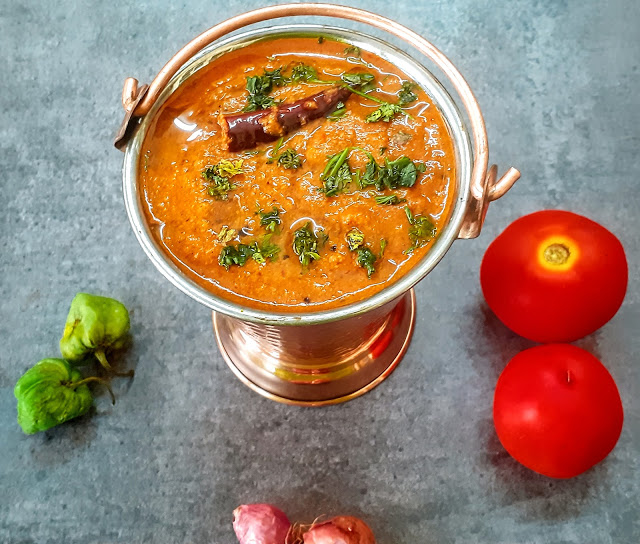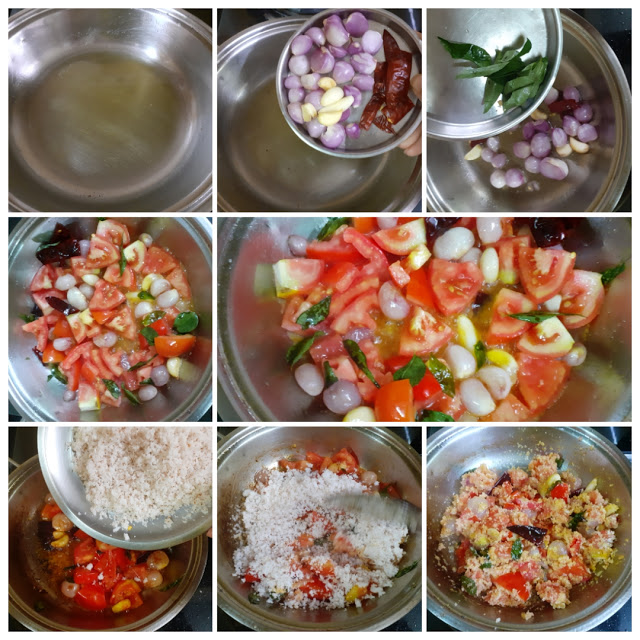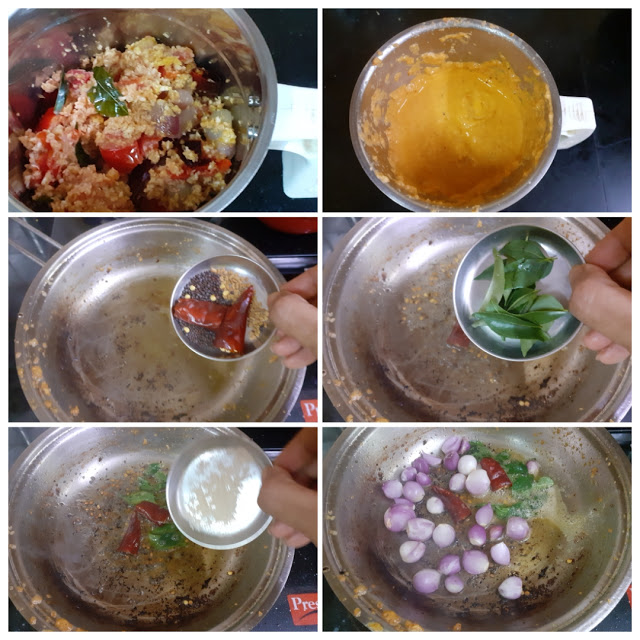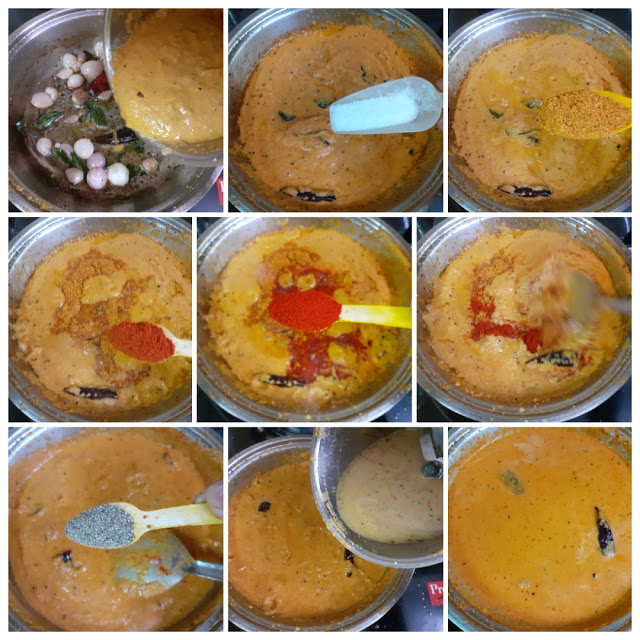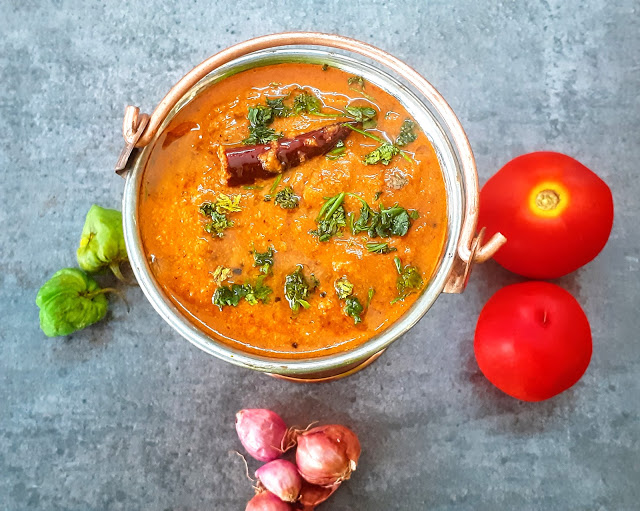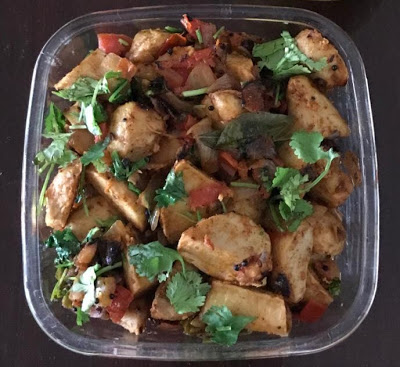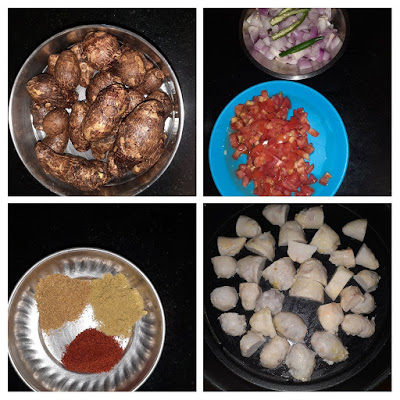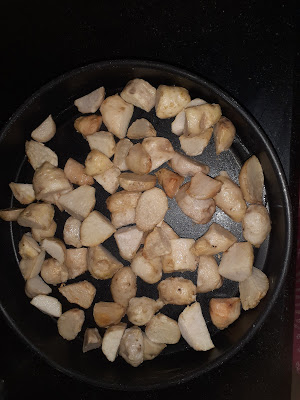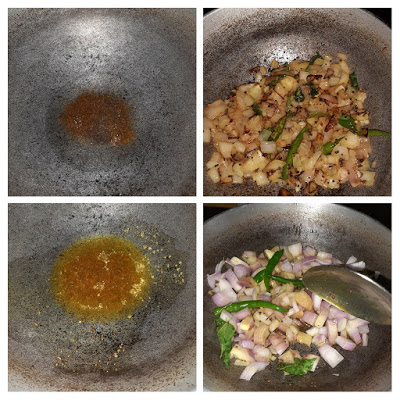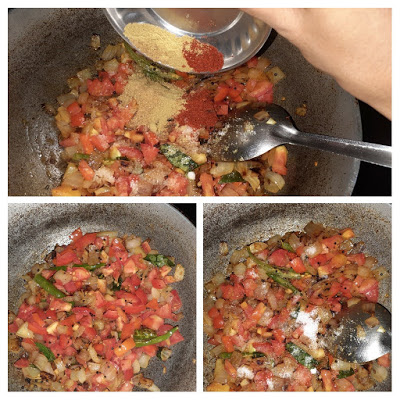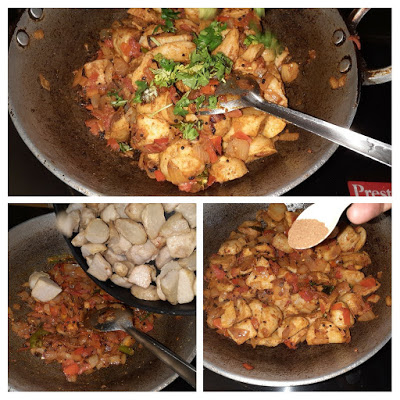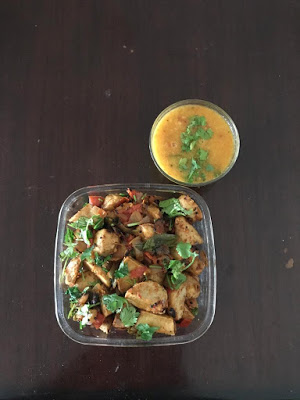Babycorn Lolipop
Alu Palak
Stuffed Sweet Peppers
Broccoli Paneer Rice
Thakkali Aati Kachina Kuzhambu
Thakkali Aati Kachina Kuzhambu is basically a Tomato curry, that goes on the sides with pretty much anything. Idli, Dosa, Parathas and Rice, all taste great with this. This a traditional recipe from the Kongunaad region of Tamil Nadu. I have deviated a little from the original recipe, a few addition/deletion of spices and condiments. The rich taste and flavour of tomatoes and the texture given by coconut, makes this curry a winner.
This curry is different from a chutney or sambar, in its basic ingredients. The consistency may be that of Sambar, but there is no dal used in this curry. Just three ingredients Shallots(Sambar onions), Tomatoes,Coconut, apart from other spices. Even better is the fact that you can store it in the fridge for a couple of days, and use as required.
If you have been following the blog, then you know by now what a tomato addict I am, and I just can’t cook without them. Anyone on the same page as me? Infact, in my social media handle I have spoken many times about my insecurity of tomatoes getting over. So much that i keep stocking excess of them. And this stocking has become excess during the pandemic lockdown. So every now and then such Tomato gravies and chutney’s are made at my place to keep consuming them????.
While you are here check out other curry recipes on the blog like Chakki Ki Shak, Rasakalan, Miloni Baby Corn and Bell peppers Curry, Menthiya keerai Kootu, Mirch Ka salan, Dum Aloo Ajwaini, and more…
Here is the recipe for Thakkali Aati Kachina Kuzhambu-
PREP TIME: 10 COOK TIME: 20 MINS
TOTAL TIME:30Mins COURSE: MAIN COURSE
CUISINE: SOUTH INDIAN SERVINGS: 6
AUTHOR: Rajni Ram
Ingredients:
Tomatoes 4 large ones
Shallots/Sambar onions 20 nos peeled (10 ahead and 10 later)
Garlic 4 cloves
Dry red chillies 4 + 1
Curry leaves a few
Coconut 2 tablespoons
Mustard seeds 1 tsp
Fenugreek seeds 1/2 tsp
Asafoetida 1/2 tsp
Salt as required
Sambar powder 1 tbsp
Red chilli powder regular 1 tsp
Kashmiri red chilli powder 1 tsp
Pepper powder 1 tsp
Oil for sauteing till oil/coconut oil/refined oil
Directions:
In a Pan/Kadai heat some oil for sauteing. Gently drop the shallots(half of them), garlic and red chillies and saute. Add curry leaves and continue to saute. When the onions start turning a light brown, add the tomatoes and saute until they turn mushy. Now add the coconut and saute for a minute or two. Put off the flame and cool the mixture. Once cool, grind this mixture to a smooth paste and keep aside. Now to the same kadai, add a little more oil and heat. Add mustard seeds, fenugreek seeds, dry red chilli and curry leaves. Add some asafoetida. Now add the remaining shallots and saute until light brown. Now add the prepared tomato paste. Also add salt, sambar powder, red chilli powder(regular), kashmiri red chilli powder, and mix well. Now add some pepper powder. Add about 2 cups water and allow the gravy to thicken. The final consistency of the gravy should be like Sambar. Enjoy with Rice, Idli Dosa, Puri or Parathas. Bon appetite.
STEPWISE RECIPE FOLLOWS:
1. In a Pan/Kadai heat some oil for sauteing. Gently drop the shallots(half of them), garlic and red chillies and saute. Add curry leaves and continue to saute. When the onions start turning a light brown, add the tomatoes and saute until they turn mushy. Now add the coconut and saute for a minute or two. Put off the flame and cool the mixture.
2. Once cool, grind this mixture to a smooth paste and keep aside. Now to the same kadai, add a little more oil and heat. Add mustard seeds, fenugreek seeds, dry red chilli and curry leaves. Add some asafoetida. Now add the remaining shallots and saute until light brown.
3. Now add the prepared tomato paste. Also add salt, sambar powder, red chilli powder(regular), kashmiri red chilli powder, and mix well. Now add some pepper powder. Add about 2 cups water and allow the gravy to thicken. The final consistency of the gravy should be like Sambar.
NOTES:
1. Country tomatoes are the best variety for this recipe, as they are a little sour.
2. Instead of adding pepper powder later, once can add whole peppercorns while sauteing the onion and tomatoes.
3. This curry can be kept in the refrigerator for 3 days and warmed up as required.
Arbi Masala (Spicy Colacassia)
A simple everyday subji. I make the Arbi/Arvi as a roast, sometimes a simple fry and it can also be added while making Sambhar or Kadi. This tuber is a little slimy, but that can be managed by dusting the Arbi with a little Besan/ Gram flour or rice flour. In this recipe, I have pre-cooked the Arbi in a pressure cooker and then baked it for the extra crispiness. You can also deep fry it. I do that quite often too. Let’s get to the recipe right away.
PREP TIME: 10Mins COOK TIME: 40Mins
TOTAL TIME: 50 Mins COURSE: MAIN
CUISINE: SOUTH INDIAN SERVINGS: 4
AUTHOR: RAJNI RAM
Ingredients:
Arbi/Colaccasia 250 gm( boiled and skin peeled)
Onions 2 roughly chopped
Tomatoes 2 large finely chopped
Green chilli 2 chopped
Fresh coriander 1 tbsp finely chopped
Salt to taste
Red chilli powder 1 tsp
Coriander powder 1.5 tsp
Fennel powder(optional) 1 tsp
Garam masala powder 1/2 tsp
oil for frying and making the masala.
Cumin 1 tsp
Curry leaves a few
Directions:
Boil the Arbi in a pressure cooker, with a little salt for 2 whistles. Stick to 2 whistles or it will turn soggy and lose the crispness in the subji. Cool it, Peel the skin cut it into medium size pieces( if very small, use as it is), and set aside. To deep-fry, take oil in a Karahi and heat it. drop the cut Arbi gently into the oil and fry until they are a nice brown and crisp.
If baking, then place them on a greased tray, drizzle a little oil over them, or you could use a brush to apply the oil and bake at 180 degrees for half an hour, turning over the Arbi midway, say around 15 mins. Bake until brown and crisp. Set aside.
Now in a pan or Karahi heat 1 tbsp oil. Add the cumin and turmeric and add the green chilli and chopped onion to this and saute well. Fry them well, but don’t get them brown. Now add in the tomatoes, salt, and all the dry spices. cook until the tomatoes break and release water and the mixture looks like a thick paste. Add the garam masala and fresh coriander and mix. Finally, add in the fried/baked Arbi and mix nicely, so that the masala paste coats it evenly. Serve hot with Parathas, Roti, or Dal Chawal.
STEPWISE RECIPE FOLLOWS
1. Assemble all ingredients. Cook Arbi in a pressure cooker for 2 whistles. cool. Peel skin, cut into cubes, and set aside.
2. Fry the cooked and cut Arbi in oil or bake in the oven at 180 degrees for 1/2 an hour. They should be nicely browned and crisp.
3. In a pan or karahi heat oil. Add the cumin and turmeric powder. Add in the green chillies and onion and fry well.
4. Add the tomatoes, salt, and all dry spices mentioned under ingredients. Saute the mixture well. The tomatoes should become soft and the mixture should resemble a semi-dry paste.
5. Add in the garam masala and chopped coriander and finally add the fried/baked Arbi and give a good stir. The masala paste should coat all the Arbi’s well. Sprinkle some more chopped coriander and we are ready to serve.
6. Serve with Rotis, Parathas, or just Dal Chawal. Enjoy. Bon Appetit.
Notes: 1. Amchur/ dry mango powder can be used along with other dry masalas if you prefer a little more tanginess. I have not added as I almost always use the country tomatoes/desi tomatoes/Naatu thakkali. They are naturally sour than the hybrid tomatoes or the Bangalore ones.
2. A little gram flour can be mixed with the dry spices and sprinkled over the Arbi before frying them. I have added besan as the Arbi is going to be mixed into the paste, and so will not taste bland.
If you tried this recipe and liked it please comment below. I would love to hear from you.
